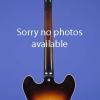The Flagship of the Epiphone Electric Line
This wonderful full-bodied (17 3/8 inches wide and 3 1/3 inches deep) "Jazzbox" weighs just 7.40 lbs. and has a really fat nut width of 1 3/4 inches and scale length of 25 1/2 inches. Laminated spruce top, laminated curly maple body, five-piece maple, walnut, and mahogany neck, and Brazilian rosewood fretboard with 20 frets and inlaid pearl block position markers with abalone "V" inserts at frets one, three, five, seven, nine, and twelve, and a pearl block at fret fifteen. The body of the guitar has five-ply binding (white/black/white/black/white) on the top and back, the neck has four-ply binding (black/white/black/white), and the headstock has three-ply binding (white/black/white). Headstock with inlaid pearl "Epiphone" script logo and pearl "Vine of Life" inlay. Individual Epiphone closed-back tuners with tulip-shaped Keystone plastic buttons. Two Epiphone "New York" pickups with strong outputs of 9.05k and 9.93k. Tortoiseshell pickguard with three-ply (white/black/white) plastic binding. Two controls (one volume, one tone) and a three-way slide switch for pickup selection, all on lower treble bout. Epiphone eight-sectioned white plastic knobs with pointers. Rosewood bridge with pre-set compensating saddle and Epiphone Frequensator tailpiece. All hardware gold-plated. Inside the bass f-hole is a rectangular white label with the model name ("Zephyr Deluxe Regent") typed and the serial number ("62827") stamped in black. Apart from some minor body checking, two tiny marks on the back of the neck, a few small marks on the top of the body by the bass f-hole and a small mark by the treble f-hole, and a few small marks on the back of the body, this guitar is in exceptionally fine (9.00) condition. Housed in its original brown Epiphone hardshell case with purple plush lining (8.50).
"Guitarists continued to play Epiphone guitars, and when World War ll ended in 1945, Epiphone renewed its battles with Gibson. One of Gibson's prewar moves had been to introduce 'cutaway' bodies, scooping out the upper treble bout to give the player easier access to the higher frets. Epi caught up after the war, offering the Emperor and De Luxe in cutaway versions in 1948. In the electric arena, Epi jumped a step ahead of Gibson in 1941 with an electric version of a high-end archtop, the Zephyr De Luxe. Shortly after the cutaway version of the De Luxe was introduced, it too was electrified (by 1949). Gibson had been improving the look and sound of its electric line, but it was 1949 before Gibson introduced an electric with the high-end trim of the L-5, called the ES-5 (ES for Electric Spanish), and 1951 before the electric versions of Gibson's L-5 cutaway and Super 400 cutaway appeared. On the marketing side, Epi showed more imagination. The electric cutaway De Luxe had the grandiose name of Zephyr De Luxe Regent. Although the Zephyr has been a separate model, the company appropriated the term 'Zephyr' to mean an electric model. 'Regent' denoted a cutaway. Thus when an electric cutaway version of the Emperor appeared in 1952, it was dubbed the Zephyr Emperor Regent" (Walter Carter, Epiphone: The Complete History, p. 43).
On par with the Gibson L-5CES, the $325.00 (1951 price) flagship of the electric line, the cutaway Zephyr De Luxe Regent was introduced in 1948 with a single pickup mounted between the neck and the bridge.
"The Zephyr De Luxe Regent debuted by 1949 an electric cutaway version of the De Luxe. The top is laminated spruce; the back and sides are laminated maple" (George Gruhn and Walter Carter, Electric Guitars and Basses: A Photographic History, p. 84).
Translate:

